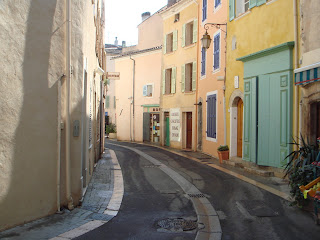



Another lovely day dawned on Saturday and, after Carol had gone to Basildon Hospital to give a blood sample we took off for Kent and East and West Sussex. Carol had the blood sample taken at the doctor's request. She had appeared to be losing weight (dresses and skirts were more loose fitting than before!) but when the Doc weighed her she was actually a bit heavier than when last checked in August!! Muscle has replaced the puppy fat!!
We had identified three National Trust Gardens to visit and of course this is the right time to go garden visiting. The first one was Standen which was the country house of the Beale family until given to the NT in 1972. The house is absolutely charming and gives a great feel of a place of family happiness. Very well maintained and with lots of orginal furniture,spacious and multi roomed, it is no wonder that there was a staff of 12 servants in its heyday. The garden affords views of the Upper Medway Valley and was designed by Margaret Beale with the help of landscape gardener G B Simpson. Meandering paths lead through rhododendrons and orchards. A most unusual item was a row of old apple trees which had been espaliered and gave two strong branches off left and right from a gnarled trunk. This resulted in a tree which was no more than six feet high - obviously assisting the apple pickers!
We lunched in the barn which was excellent and then drove off to Wakehurst.This enormous park is part of the famous Kew Gardens.Of particular interest was the Southern Hemisphere Garden, and it was quite nostagic to see beautiful gum trees,banksia and tea trees.There was also a specimen of the Wollemi Pine, a tree which had been extinct for some 2 million years and was discovered in a valley West of Sydney in the 1970's.Its exact location is kept a closely guarded secret. A specimen was acquired by Kew and is thriving in these gardens. A couple of fat pheasants sat quite unperturbed as we walked past and ducks lay quietly ignoring the passers by.
Then a final drive to Sheffield Park Garden. En route we stopped in at the Blue Bell Railway where steam trains operate along a preserved rail line. We obtained details of the timetable and plan to make a further visit when we have time to take a trip.
Our Australian National Trust membership card provoked the question of whether we were aware of the Australian connection to Sheffield. It is of course the Sheffield Shield. In 1891 the Earl of Sheffield sponsored a cricket team (including the famous W G Grace) on a visit to Australia, and donated L150 to promote "intercolonial cricket" to be know as the Sheffield Shield - now more commercially known as the Pura Cup!!
Another brilliant garden situated around four lakes. Designed by the famous Capability Brown in the 18th century and further dveloped in the 20th century by its owner Arthur G Soames there are masses of azalias and rhododendrons underpinned with daffodils and bluebells. The bottom photo above is a view across one of the lakes and I think is a great picture.
I think we have probably "done" the garden bit now, and for the long weekend ahead we are now going to visit London.


























